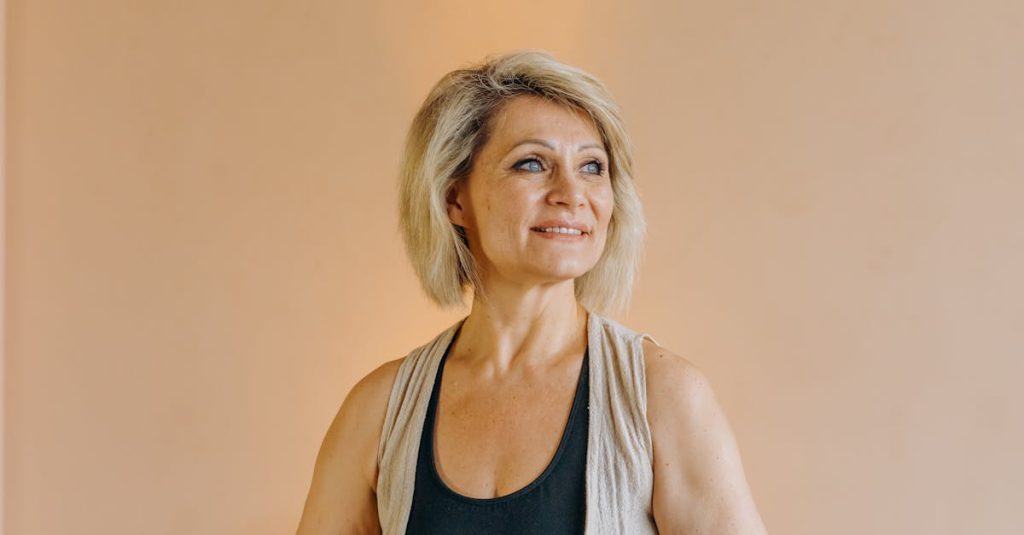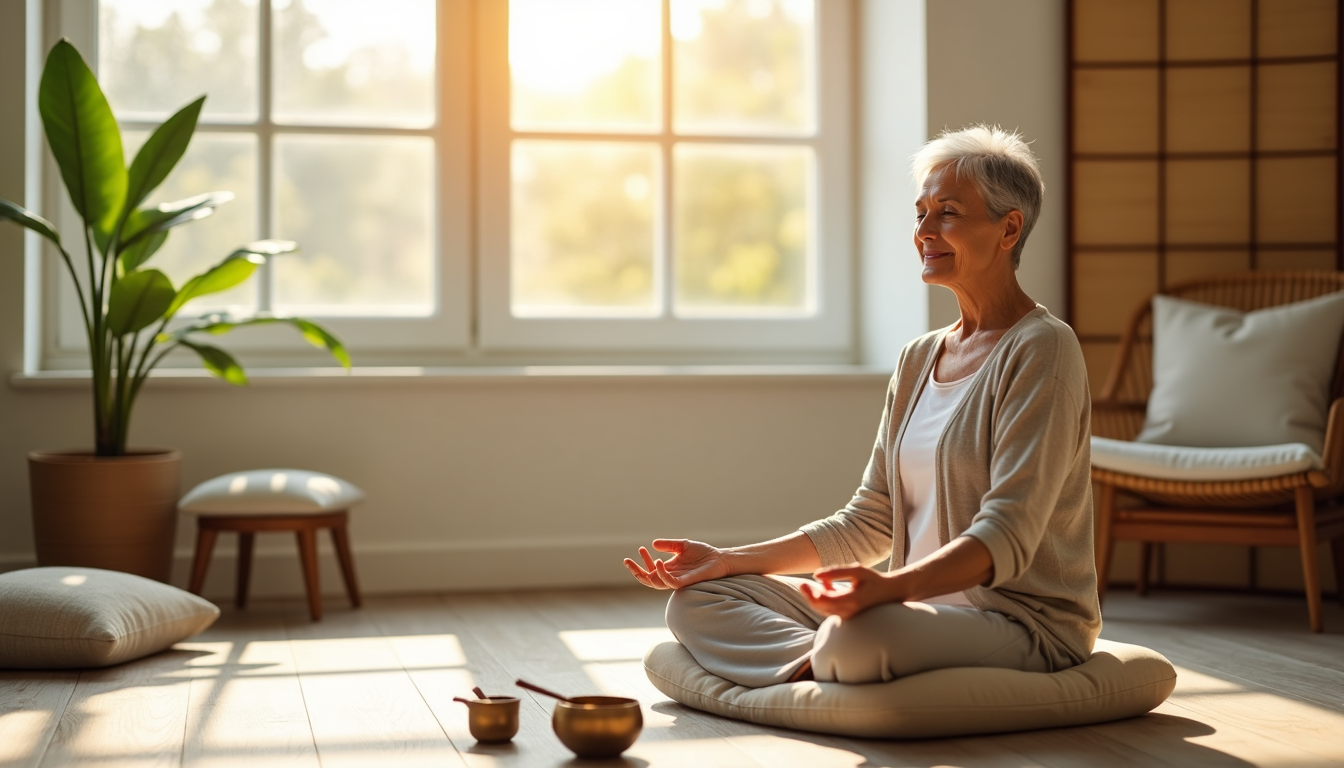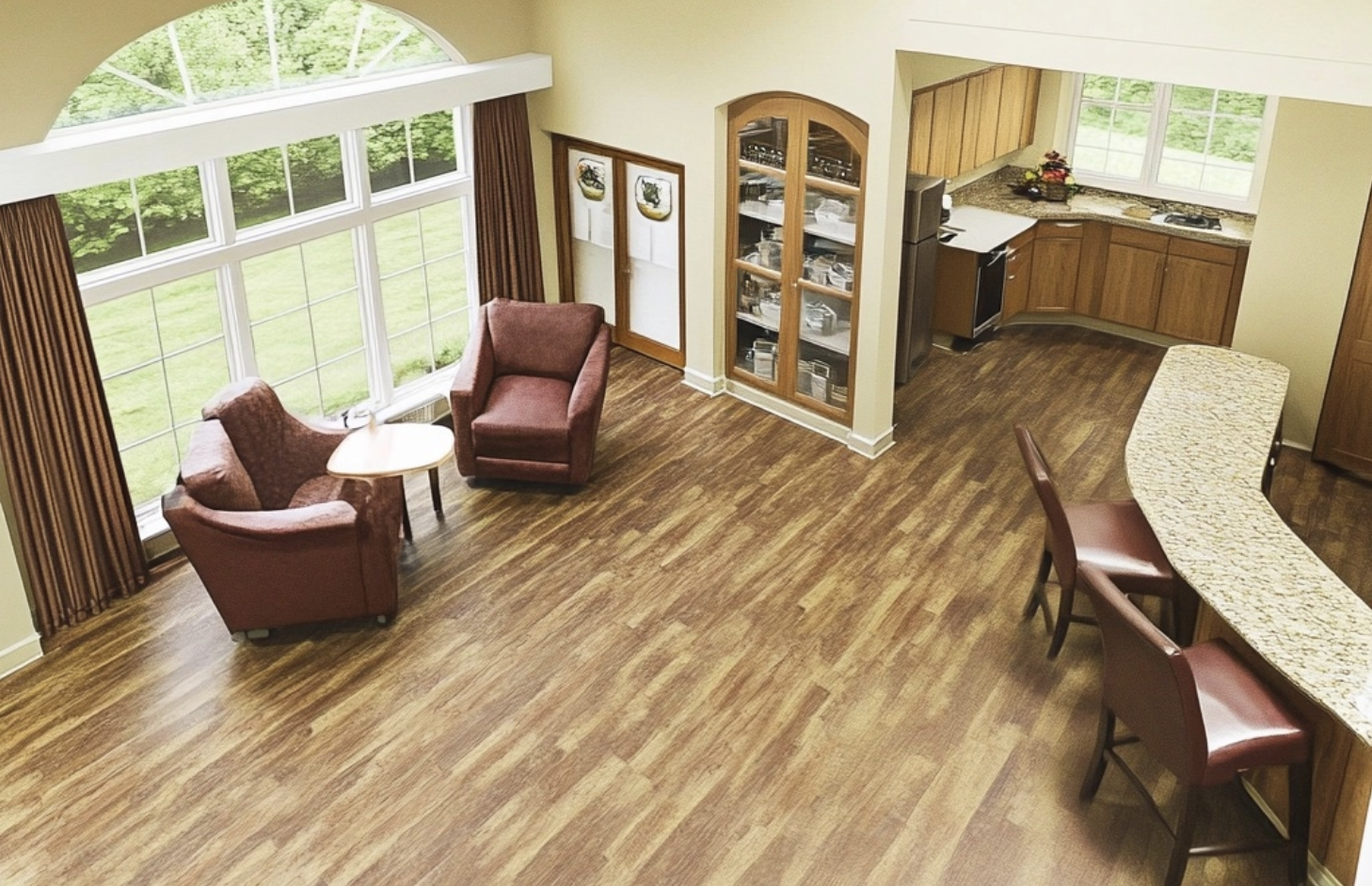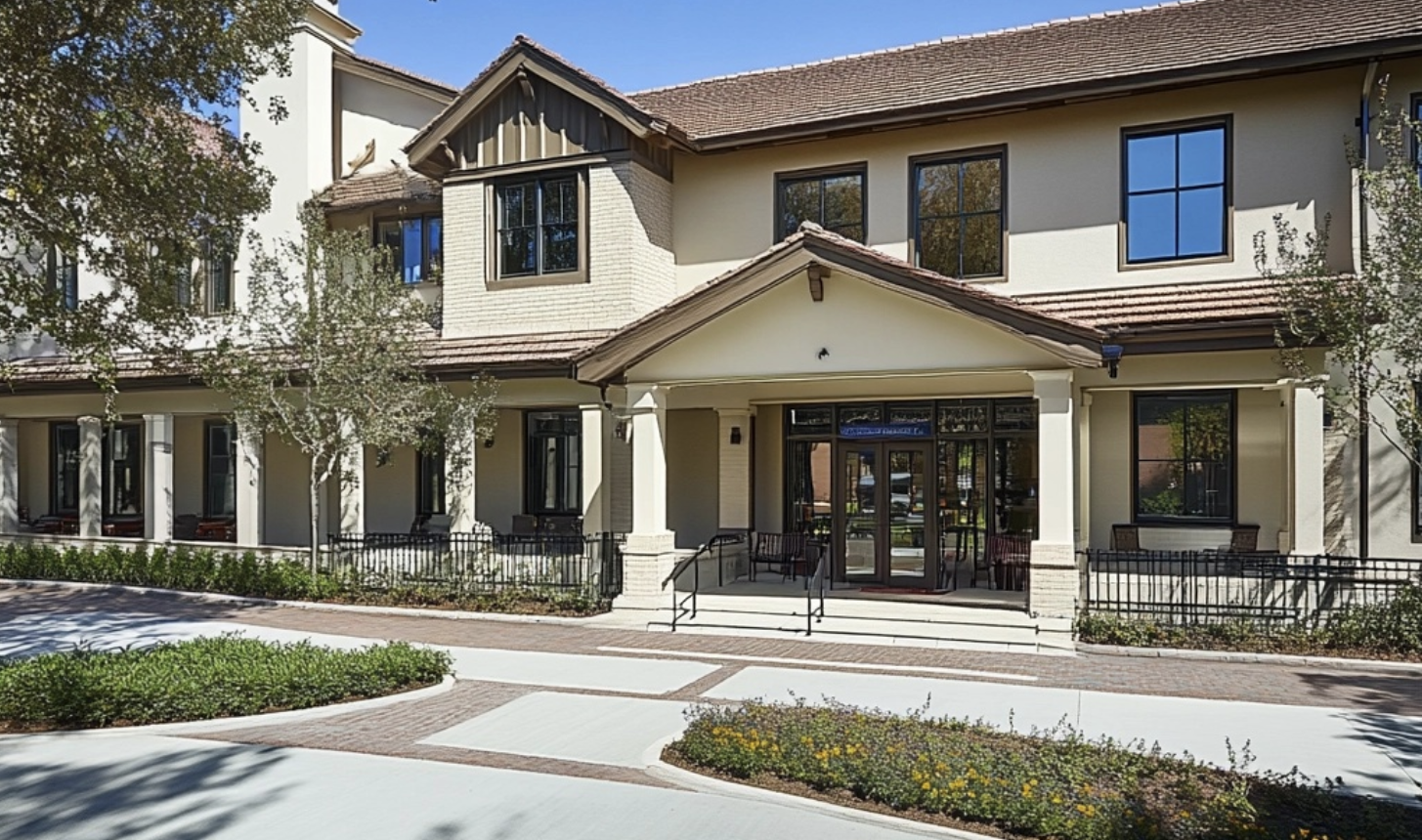The number of adults over 65 will double in the next 25 years, according to demographic projections. This aging trend makes meditation for seniors increasingly relevant as a health intervention. By 2030, older adults will account for 20% of the U.S. population, while facing substantial mental health challenges. Statistics show nearly 30% of seniors in long-term care facilities experience symptoms of depression.
Research indicates promising outcomes for older adults who engage in mindfulness practices. A 2023 study found that seniors practicing meditation showed better survival rates and reduced disability compared to non-practitioners. The data reveals mindfulness meditation significantly decreases depression symptoms while improving cognitive function in elderly participants.
Mindfulness practices offer multiple benefits for seniors, from enhanced immune response to improved memory performance. Evidence suggests regular meditation creates measurable changes in brain activity associated with better emotional regulation and attention. These practices can be adapted for various physical abilities and easily incorporated into daily routines for older adults seeking to maintain cognitive health.
Understanding Meditation and Mindfulness for Seniors
Meditation offers significant advantages for older adults seeking to maintain cognitive and physical health. Research indicates mindfulness meditation provides specific benefits tailored to seniors’ needs, with evidence suggesting this practice addresses multiple age-related challenges.
What is mindfulness meditation?
Mindfulness meditation stems from ancient Buddhist traditions but has been adapted for contemporary secular use. Jon Kabat-Zinn, developer of the Mindfulness-Based Stress Reduction program, defines it as “the awareness that arises from paying attention, on purpose, in the present moment and non-judgmentally”.
The practice involves training the mind to focus while maintaining present-moment awareness. Unlike passive relaxation activities, mindfulness meditation requires active mental engagement and intention.
Practitioners typically follow several key steps during meditation sessions:
- Focusing on a specific “object of awareness” like breathing
- Noticing when attention wanders
- Redirecting focus back to the present moment
- Observing thoughts without judgment
Research demonstrates mindfulness training substantially benefits mood regulation and reduces symptoms of anxiety and stress-related disorders. Studies show it decreases stress and functional impairment associated with chronic conditions including pain, cancer, and rheumatoid arthritis.
How meditation differs from relaxation
Many people incorrectly equate meditation with standard relaxation techniques, but fundamental differences exist between these practices. While both may reduce stress, they operate through different mechanisms.
Relaxation typically involves “loosening” activities—such as watching television or listening to music—where the mind wanders without particular focus. The primary goal is unwinding and releasing tension.
Meditation, by contrast, requires alertness and focused attention. Practitioners actively work to quiet the mind through concentration rather than allowing it to “go limp” as in relaxation.
Studies indicate meditation produces deeper relaxation effects and reduces stress more effectively than general relaxation techniques. Individuals who practice meditation report decreased anxiety, enhanced personal clarity, and greater overall satisfaction—benefits not commonly associated with relaxation alone.
Why aging makes meditation especially valuable
Meditation becomes particularly beneficial during later life stages for several research-backed reasons. Studies suggest older adults may actually possess advantages when practicing mindfulness techniques.
Research indicates self-reported mindfulness scores are naturally higher in older adults. Seniors typically develop the emotional aspects of mindfulness—including nonjudgmental awareness and nonreactivity—more quickly than younger adults.
Beyond this natural affinity, meditation directly addresses numerous age-related challenges. Preliminary evidence suggests it supports brain plasticity—the brain’s capacity to adapt and change—which remains possible throughout the lifespan. This finding carries significant implications for cognitive health in aging populations.
Regular meditation practice improves memory, focus, attention, and concentration. Research shows it may help counter known risk factors for dementia development, including chronic stress, anxiety, and depression.
For older adults facing physical limitations, meditation provides tangible benefits. Studies demonstrate mindfulness reduces pain intensity, enhances sleep quality, and potentially strengthens immune function. The practice offers effective tools for managing grief, loneliness, and emotional transitions commonly experienced during aging.
Given these extensive benefits, meditation represents a valuable health intervention particularly suited to the needs and natural tendencies of older adults.
Physical Health Benefits of Regular Meditation
Regular meditation creates measurable changes in bodily functions that significantly benefit seniors’ physical health, according to multiple studies. Research shows consistent mindfulness practice affects several key physiological systems, improving quality of life for older adults.
Lowering blood pressure and heart rate
High blood pressure affects numerous older adults, but meditation offers a natural management approach alongside traditional treatments. Studies demonstrate that both mindfulness and transcendental meditation produce significant reductions in blood pressure readings.
Elderly participants with difficult-to-treat isolated systolic hypertension who practiced relaxation response techniques showed better blood pressure control in one landmark study. Some participants even reduced or eliminated their medications entirely. Another study found seniors practicing Zen meditation twice daily for 20 minutes experienced significant decreases in systolic blood pressure after just one month.
Meditation works by reducing stress responses while activating relaxation pathways in the body. This mechanism decreases heart rate, lowers blood pressure measurements, and reduces levels of stress hormones like adrenaline and cortisol.
Managing chronic pain conditions
Approximately 20.4% of adults suffer from chronic pain—a percentage that rises among those 65 and older. Meditation provides these individuals with effective coping strategies. Mindfulness specifically helps by changing one’s relationship with pain rather than completely eliminating discomfort.
A University of Michigan research team studying older adults with chronic low back pain found an 8-week mindfulness program led to significant improvements in pain acceptance and physical function. Participants reported engaging in more activities despite pain, with many reducing their pain medication usage.
Jon Kabat-Zinn, who pioneered mindfulness for pain management, emphasizes that the goal isn’t pain elimination but rather “getting to know it and learning from it”. Through focused attention and non-judgmental awareness, seniors develop a different relationship with chronic discomfort.
Strengthening immune function
Meditation strengthens immune system function—particularly important for seniors who typically experience immune decline with age. Research shows:
- Eight days of intensive meditation practice causes “robust activation of the immune system”
- Meditation activates 220 genes directly related to immune response
- Mindfulness increases activity in 68 genes associated with interferon signaling—critical for fighting viruses and cancer
- Regular practitioners show reduced inflammation markers and increased cell-mediated immunity
This immune-boosting effect becomes increasingly valuable as people age, potentially helping seniors resist infections and recover more quickly from illness.
Improving sleep quality and duration
Many seniors struggle with sleep disturbances, but meditation offers effective relief. A study published in JAMA Internal Medicine found adults who completed a mindfulness awareness program experienced less insomnia, fatigue, and depression compared to those receiving only sleep education.
These benefits occur because meditation calms stress pathways in the brain and reduces stress hormone levels. The practice also decreases ruminative thoughts and emotional reactivity that often keep older adults awake at night.
Seniors dealing with disrupted sleep patterns find that pre-bedtime meditation releases bodily tension and creates a peaceful mental state. Practitioners typically report falling asleep faster, staying asleep longer, and enjoying more rejuvenating rest.
Mental Health Improvements Through Mindfulness
Mindfulness practices significantly benefit seniors dealing with the emotional challenges of aging, according to multiple studies. Research shows regular meditation creates measurable changes in mental wellness that work alongside the physical benefits previously discussed.
Reducing anxiety and depression symptoms
Studies published in the Journal of the American Medical Association demonstrate that mindfulness meditation boosts mood and helps people overcome depression. Research suggests meditation may be as effective as antidepressants for relieving depressive symptoms in some patients.
A comprehensive meta-analysis examining meditation effects found mindfulness interventions significantly improved depression in older adults, with an effect size of 0.65. The data revealed guided meditation proved substantially more effective (0.91) than unguided practice (0.42).
Mindfulness works by addressing anxiety disorder symptoms and reducing intrusive thoughts that contribute to emotional strain. Regular practice helps seniors develop heightened self-awareness and emotional balance that improves stress management throughout daily activities.
Coping with grief and life transitions
Grief encompasses more than losing loved ones—it includes significant life changes like retirement, health transitions, and shifting social relationships. Mindfulness offers practical tools for navigating these complex emotional experiences.
Mindful grieving involves acknowledging emotions without judgment or attempted suppression. One grief advocate points out, “Looking at grief as a problem to be solved, instead of something to be tended and respected, is the main way that 90 percent of grief support is doing it wrong”.
Meditation provides a structured space for experiencing emotions fully rather than avoiding them. This approach helps seniors process grief by creating positive changes in brain function during quiet, contemplative moments.
Building emotional resilience
The American Psychological Association defines resilience as “the process of adapting well in the face of adversity” or “bouncing back” from difficult experiences. Research indicates psychological resilience actually increases with age rather than diminishing.
Studies reveal several notable findings about senior resilience:
- Adults 85+ show equal or greater resilience compared to younger populations
- People aged 100+ demonstrate the highest resilience among older age groups
- Individuals 94-98 years old with high resilience were 43.1% more likely to reach 100 than those with low resilience scores
Mindfulness practices enhance this natural tendency toward greater resilience. Seniors with higher resilience levels adapt better to change and show improved coping with health challenges. Even among those with chronic illnesses, resilient individuals report better quality of life, mental health, and overall happiness.
Regular mindfulness meditation helps seniors develop stronger coping mechanisms and cultivate optimism—key components of emotional resilience supporting healthy aging.
Easy Meditation Techniques Designed for Seniors

Meditation techniques need not be complex to deliver benefits for seniors. Research shows several straightforward practices accommodate different physical abilities while providing significant health improvements. These methods can be integrated into daily routines with minimal disruption.
Seated breathing meditation
Seated breathing meditation provides an accessible starting point for beginners. The practice requires finding a comfortable chair that supports proper posture while keeping feet flat on the floor. Practitioners focus on their breath, inhaling deeply to a count of eight, holding briefly, then exhaling completely. Research indicates this technique works particularly well when performed for 30 minutes before bedtime.
To practice effectively:
- Straighten the spine and place hands on the belly
- Notice breathing sensations in the abdomen
- Close the eyes if comfortable
- Count breaths silently to maintain focus
Studies demonstrate this approach stimulates endorphin secretion in the brain, creating feelings of relaxation and happiness.
Body scan for physical awareness
Body scan meditation helps seniors reconnect with physical sensations while identifying areas of tension. The technique trains the mind to become more receptive to sensory experiences, making it an effective entry point for mindfulness practice.
The body scan process involves:
- Lying down comfortably or sitting in a supported position
- Starting at either feet or head and systematically moving through the body
- Noticing sensations without judgment
- Breathing into areas of tension to promote relaxation
Research shows this technique improves sleep quality and overall quality of life when practiced daily over an eight-week period.
Walking meditation for active seniors
Walking meditation transforms routine movement into mindfulness practice, delivering both physical and mental benefits. The technique requires finding a path allowing 10-15 paces (approximately 20-40 feet) in an undisturbed location.
Practitioners move slowly and deliberately, focusing on walking components: lifting the foot, moving it forward, placing it down, and shifting weight. Alternatively, attention can focus on environmental elements—sounds, sights, smells, or tactile sensations beneath the feet.
Studies indicate mindful walking improves processing speed and executive function specifically in older adults.
Guided visualization practices
Guided visualization employs imagination to create peaceful mental states. The technique remains accessible for individuals across all fitness levels.
The practice begins with comfortable, upright sitting. With eyes closed, practitioners allow themselves to follow verbal guidance—perhaps visualizing a quiet forest path or colors associated with calmness. The primary objective involves creating a sensory experience promoting deep relaxation.
Research shows many seniors find guided imagery helpful for sleep onset, anxiety reduction, and enhanced overall well-being. The practice can be facilitated through meditation apps, videos, or audio recordings specifically designed for older adults.
Creating a Sustainable Meditation Routine
Establishing a consistent meditation practice requires intention and planning, similar to developing any new habit. Research shows successful meditation routines start with modest goals before gradually expanding. Several key strategies help seniors integrate mindfulness into their daily lives without feeling overwhelmed.
Starting small: 5-minute sessions
Duration matters less than consistency when beginning meditation practice. Meditation teachers typically recommend starting with brief 5-minute sessions before gradually extending practice time as comfort increases. These short sessions prevent overwhelm while still delivering measurable benefits for seniors new to meditation.
“Start slow and begin with just a few minutes of meditation each day,” the Elite Care Health Center advises. This measured approach helps establish meditation as a natural part of daily routines, increasing the likelihood of long-term adherence.
Finding the right time of day
Morning meditation offers distinct advantages, according to mindfulness experts. Scheduling meditation early makes it a fixed part of the day before other priorities emerge. These morning sessions often establish a calmer mindset that carries throughout daily activities.
Research comparing morning versus evening meditation found both timeframes decreased anxiety and increased mindfulness measurements. The optimal practice time ultimately depends on individual schedules and preferences. Mindfulness teacher Dora Kamau notes, “The most optimal time is the one that allows you to stay consistent with your practice”.
Setting up a comfortable meditation space
A dedicated meditation area significantly supports regular practice. Creating this space doesn’t require an entire room—a corner, alcove, or garden space works effectively. The primary requirement involves finding a quiet location free from distractions.
Meditation spaces should remain clean and uncluttered, as “clutter around us will have us feeling more cluttered in our minds”. The area should provide comfortable seating with proper support, whether using cushions, a chair, or even a bed for those with mobility limitations.
Using technology as a meditation aid
Several apps make meditation more accessible for seniors with varying experience levels. Free or low-cost options include:
- Healthy Minds – Offers podcast-style, audio-guided lessons developed by the University of Wisconsin-Madison
- Mindfulness Coach – Created by the VA to help reduce stress and improve emotional balance
- AARP Virtual Community Center – Provides free online meditation classes regardless of membership status
These digital tools provide structured guidance that helps maintain consistency, particularly during the beginning stages of practice.
Creating a sustainable meditation routine ultimately involves identifying what works best for individual preferences and making the practice a non-negotiable part of daily life.
Conclusion
Research indicates mindfulness meditation provides substantial benefits for healthy aging, addressing both physical and psychological challenges common among seniors. Studies show older adults possess a natural inclination toward mindfulness practices, potentially making meditation particularly effective for enhancing quality of life in later years.
Meditation’s accessibility represents one of its greatest strengths. The practice requires no special equipment, minimal space, and can be performed regardless of physical limitations. Whether through breathing exercises, body scans, or guided visualizations, these techniques integrate easily into existing routines. Evidence suggests even five-minute daily sessions produce measurable improvements in sleep quality, stress reduction, and emotional regulation.
Data from multiple studies demonstrates meditation’s effects on reducing blood pressure, managing chronic pain, and improving cognitive function in older adults. The practice appears to address several age-related health concerns simultaneously, making it a versatile intervention for seniors seeking to maintain independence and well-being.
Successful meditation practice doesn’t depend on perfect conditions or extensive experience. As research continues documenting mindfulness benefits for aging populations, meditation emerges as a practical tool for maintaining cognitive function and emotional balance throughout the later years of life.
FAQs
Q1. How can meditation benefit seniors specifically? Meditation offers numerous benefits for seniors, including improved sleep quality, reduced stress and anxiety, better emotional regulation, and enhanced cognitive function. It can also help manage chronic pain, lower blood pressure, and strengthen the immune system, making it an excellent tool for maintaining overall health and well-being in later years.
Q2. What are some easy meditation techniques for older adults? Seniors can start with simple techniques like seated breathing meditation, body scan for physical awareness, walking meditation for active seniors, and guided visualization practices. These methods are designed to accommodate different physical abilities and can be easily incorporated into daily routines.
Q3. How long should seniors meditate to see benefits? Starting with just 5-minute sessions can be beneficial. Consistency is more important than duration, especially when beginning. As you become more comfortable, you can gradually extend your practice. Even short daily sessions can lead to noticeable improvements in mental and physical well-being over time.
Q4. Can meditation help with age-related cognitive decline? Yes, research suggests that regular meditation practice may support brain plasticity and cognitive function in older adults. It has been shown to improve memory, focus, and concentration, potentially offsetting some risk factors associated with cognitive decline and dementia.
Q5. How can seniors create a sustainable meditation routine? To establish a sustainable meditation practice, seniors should start small with brief sessions, find the right time of day that works for them, set up a comfortable and dedicated meditation space, and consider using technology like meditation apps for guidance. Consistency and patience are key to making meditation a regular part of your daily life.




